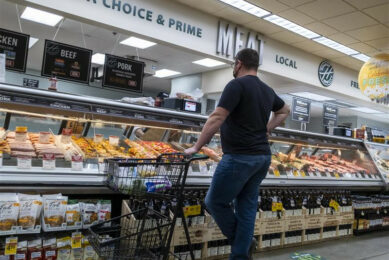Pork industry also facing economic uncertainty
These are uncertain times, not only for grain producers but for livestock producers as well. Worried investors are sending the stock market and agricultural markets reeling. After all, it is the incomes of world consumers that are the foundation of pork demand.
US consumers have been shaken and the pork industry has never been so dependent on incomes of the world’s consumers as pork exports have lead prices higher. Christ Hurt, Extension Economist of Purdue University asks, what are prospects for the industry in the coming year?
Breeding herd reductions
Anticipation of smaller supplies should be supportive to hog prices. The just released USDA Hogs and Pigs report does suggest that US producers are following through on their intentions to reduce the breeding herd and cut production for 2009. The nation’s breeding herd is down 3 percent and producers indicate they will cut farrowings by 5 percent this fall and another 3 percent in the winter. However, record weaning rates mean that supplies will not be down by the same percentage.
Record high weaning rates are nothing new to the US pork industry. The number of pigs per litter will be nearly 2 percent higher in 2008 as extremely high feed prices have forced the industry to trim low-productive sows and encouraged management practices to save more pigs. The rate at which pigs per litter grows is highly affected by feed costs. The last time the growth rate in pigs per litter was at 2 percent a year was in 1996 and 1997 when corn prices moved above $5.00 per bushel.
US pork production is expected to remain up about 3 percent in the fourth quarter before dropping one to 2 percent in 2009. Pork trade has been the outstanding feature of 2008. So far this year, pork exports have been up 71 percent and imports down 16 percent. Net trade (exports minus imports) has accounted for 18 percent of US production.
Domestic production up
This compares with 10 percent last year. This means an additional 8 percent of US production is not available to US consumers because of trade. Given that domestic production is up about 7 percent this year, trade is the only reason hog prices were able to recover so sharply this spring and summer.
Several cracks in the bullish trade numbers have developed, however. China was by far the leader of added exports, representing 46 percent of the additional exports through July. The rate of exports to China dropped in July, giving rise to concerns they may reduce purchases in the post-Olympic period. Russia has also been an important buyer of pork this year, accounting for 13 percent of the growth in US exports in the first seven months.
Russian Exports
Continued exports to Russia are in jeopardy as Russia retaliates for US diplomatic criticism of Russia’s incursions into Georgia. Russia has sought to ban some imports from the US on health and sanitation reasons and is attempting to stimulate their own domestic production through government supports of their industry. Most importantly, Russian pork purchases represented only 2 percent of US production so far this year, so a total loss of that business is not terribly bearish to prices.
Hog prices, as measured by live prices for 51 to 52 percent hog carcasses, are expected to average in the high $40s to very low $50s for the fourth quarter of 2008. Prices are expected to be in the low $50s this winter and move into the high $50s to very low $60s in the spring and summer. For the calendar year of 2009, hog prices are expected to average in the mid-to-upper $50s
Current estimates of costs for 2009 are in the mid-$50s, resulting in an estimate for modest profits for the year. Feed prices are highly unstable at this writing so much uncertainty is added for pork producers from the feed cost side as well. Given the current forecasts of hog prices and costs, producers could pay about $5.25 for corn in 2009 and still breakeven.
Corn prices
This compares with a corn breakeven purchase price of only $3.75 per bushel for 2008. Since corn prices will average closer to $5.00 a bushel, this means considerable losses in 2008, on average.
What of the current financial difficulties for the US economy? Will consumers back away from meat consumption given the uncertainty in their incomes and reduced value of their stock portfolios? Beef consumption will feel the impacts much more strongly than pork since pork is much lower priced. For 2008, retail beef prices have averaged $4.26 per pound and retail pork has averaged $2.90 per pound. In recent years, the level of consumer incomes has had little impact on pork consumption. However, pork prices can be expected to experience some negative reactions to consumer income uncertainty.
Both crop and animal agriculture are ready for more stability, but a movement toward more stability cannot yet be seen from today’s vantage point.
Source; Chris Hurt, Purdue University
Related Website
Purdue university
Click here for the free Pig Progress newsletter
Record high weaning rates are nothing new to the US pork industry. The number of pigs per litter will be nearly 2 percent higher in 2008 as extremely high feed prices have forced the industry to trim low-productive sows and encouraged management practices to save more pigs. The rate at which pigs per litter grows is highly affected by feed costs. The last time the growth rate in pigs per litter was at 2 percent a year was in 1996 and 1997 when corn prices moved above $5.00 per bushel.
US pork production is expected to remain up about 3 percent in the fourth quarter before dropping one to 2 percent in 2009. Pork trade has been the outstanding feature of 2008. So far this year, pork exports have been up 71 percent and imports down 16 percent. Net trade (exports minus imports) has accounted for 18 percent of US production.
Domestic production up
This compares with 10 percent last year. This means an additional 8 percent of US production is not available to US consumers because of trade. Given that domestic production is up about 7 percent this year, trade is the only reason hog prices were able to recover so sharply this spring and summer.
Several cracks in the bullish trade numbers have developed, however. China was by far the leader of added exports, representing 46 percent of the additional exports through July. The rate of exports to China dropped in July, giving rise to concerns they may reduce purchases in the post-Olympic period. Russia has also been an important buyer of pork this year, accounting for 13 percent of the growth in US exports in the first seven months.
Russian Exports
Continued exports to Russia are in jeopardy as Russia retaliates for US diplomatic criticism of Russia’s incursions into Georgia. Russia has sought to ban some imports from the US on health and sanitation reasons and is attempting to stimulate their own domestic production through government supports of their industry. Most importantly, Russian pork purchases represented only 2 percent of US production so far this year, so a total loss of that business is not terribly bearish to prices.
Hog prices, as measured by live prices for 51 to 52 percent hog carcasses, are expected to average in the high $40s to very low $50s for the fourth quarter of 2008. Prices are expected to be in the low $50s this winter and move into the high $50s to very low $60s in the spring and summer. For the calendar year of 2009, hog prices are expected to average in the mid-to-upper $50s
Current estimates of costs for 2009 are in the mid-$50s, resulting in an estimate for modest profits for the year. Feed prices are highly unstable at this writing so much uncertainty is added for pork producers from the feed cost side as well. Given the current forecasts of hog prices and costs, producers could pay about $5.25 for corn in 2009 and still breakeven.
Corn prices
This compares with a corn breakeven purchase price of only $3.75 per bushel for 2008. Since corn prices will average closer to $5.00 a bushel, this means considerable losses in 2008, on average.
What of the current financial difficulties for the US economy? Will consumers back away from meat consumption given the uncertainty in their incomes and reduced value of their stock portfolios? Beef consumption will feel the impacts much more strongly than pork since pork is much lower priced. For 2008, retail beef prices have averaged $4.26 per pound and retail pork has averaged $2.90 per pound. In recent years, the level of consumer incomes has had little impact on pork consumption. However, pork prices can be expected to experience some negative reactions to consumer income uncertainty.
Both crop and animal agriculture are ready for more stability, but a movement toward more stability cannot yet be seen from today’s vantage point.
Source; Chris Hurt, Purdue University
Related Website
Purdue university
Click here for the free Pig Progress newsletter











